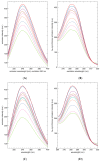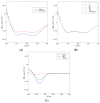On the Cholesterol Raising Effect of Coffee Diterpenes Cafestol and 16- O-Methylcafestol: Interaction with Farnesoid X Receptor
- PMID: 38892285
- PMCID: PMC11173301
- DOI: 10.3390/ijms25116096
On the Cholesterol Raising Effect of Coffee Diterpenes Cafestol and 16- O-Methylcafestol: Interaction with Farnesoid X Receptor
Abstract
The diterpene cafestol represents the most potent cholesterol-elevating compound known in the human diet, being responsible for more than 80% of the effect of coffee on serum lipids, with a mechanism still not fully clarified. In the present study, the interaction of cafestol and 16-O-methylcafestol with the stabilized ligand-binding domain (LBD) of the Farnesoid X Receptor was evaluated by fluorescence and circular dichroism. Fluorescence quenching was observed with both cafestol and 16-O-methylcafestol due to an interaction occurring in the close environment of the tryptophan W454 residue of the protein, as confirmed by docking and molecular dynamics. A conformational change of the protein was also observed by circular dichroism, particularly for cafestol. These results provide evidence at the molecular level of the interactions of FXR with the coffee diterpenes, confirming that cafestol can act as an agonist of FXR, causing an enhancement of the cholesterol level in blood serum.
Keywords: 16-O-methylcafestol; FXR; cafestol; circular dichroism; coffee; fluorescence.
Conflict of interest statement
Authors Elena Guercia and Luciano Navarini were employed by the company illycaffè S.p.A. The remaining authors declare that the research was conducted in the absence of any commercial or financial relationships that could be construed as a potential conflict of interest.
Figures

















Similar articles
-
The cholesterol-raising factor from coffee beans, cafestol, as an agonist ligand for the farnesoid and pregnane X receptors.Mol Endocrinol. 2007 Jul;21(7):1603-16. doi: 10.1210/me.2007-0133. Epub 2007 Apr 24. Mol Endocrinol. 2007. PMID: 17456796
-
Interaction of the Coffee Diterpenes Cafestol and 16-O-Methyl-Cafestol Palmitates with Serum Albumins.Int J Mol Sci. 2020 Mar 6;21(5):1823. doi: 10.3390/ijms21051823. Int J Mol Sci. 2020. PMID: 32155814 Free PMC article.
-
Possible mechanisms underlying the cholesterol-raising effect of the coffee diterpene cafestol.Curr Opin Lipidol. 1999 Feb;10(1):41-5. doi: 10.1097/00041433-199902000-00008. Curr Opin Lipidol. 1999. PMID: 10095989 Review.
-
Interaction of coffee compounds with serum albumins. Part II: Diterpenes.Food Chem. 2016 May 15;199:502-8. doi: 10.1016/j.foodchem.2015.12.051. Epub 2015 Dec 11. Food Chem. 2016. PMID: 26776001
-
New trends in coffee diterpenes research from technological to health aspects.Food Res Int. 2020 Aug;134:109207. doi: 10.1016/j.foodres.2020.109207. Epub 2020 Apr 2. Food Res Int. 2020. PMID: 32517949 Review.
Cited by
-
Unraveling tea and coffee consumption effects on cardiovascular diseases risk factors: A narrative review.Health Sci Rep. 2024 Sep 25;7(9):e70105. doi: 10.1002/hsr2.70105. eCollection 2024 Sep. Health Sci Rep. 2024. PMID: 39323459 Free PMC article.
-
Coffee: Fuel for Your Day or Foe for Your Arteries.Antioxidants (Basel). 2024 Nov 27;13(12):1455. doi: 10.3390/antiox13121455. Antioxidants (Basel). 2024. PMID: 39765784 Free PMC article. Review.
-
Toxicological Risk Assessment of Coffee Oil (Coffee Seed Oil and Spent Coffee Grounds Oil) as a Novel Food with Focus on Cafestol.Molecules. 2025 Jul 12;30(14):2951. doi: 10.3390/molecules30142951. Molecules. 2025. PMID: 40733217 Free PMC article. Review.
References
-
- Statista Coffee Consumption Worldwide from 2012/13 to 2021/22 with a Forecast to 2022/23. 2023. [(accessed on 31 October 2023)]. Available online: https://www.statista.com/statistics/292595/global-coffee-consumption/
MeSH terms
Substances
LinkOut - more resources
Full Text Sources
Medical

